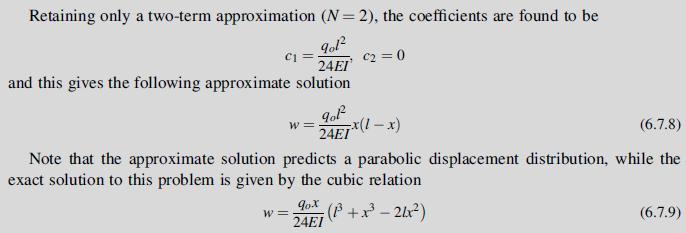Using the bending formulae (6.6.9), compare the maximum bending stresses from the cases presented in Example 6.2
Question:
Using the bending formulae (6.6.9), compare the maximum bending stresses from the cases presented in Example 6.2 and Exercise 6.18 . Numerically compare these results with the exact solution; see (6.7.9) at midspan x = l/2.
Data from example 6.2
Consider a simply supported Euler-Bernoulli beam of length l carrying a uniform loading qo. This one-dimensional problem has displacement boundary conditions:

With no nonhomogeneous boundary conditions, wo = 0. For this example, we choose a polynomial form for the trial solution. An appropriate choice that satisfies the homogeneous conditions (6.7.4) is wj = x j (l – x). Note this form does not satisfy the traction conditions (6.7.5). Using the previously developed relation for the potential energy (6.6.12), we get:
![2 dw II = = [[#1 (22) - 9ow]dx dx 2 N L'H * S ( = N 0-1)-2-j0j +1)xj-] - 90 cx (1-x) dx](https://dsd5zvtm8ll6.cloudfront.net/images/question_images/1704/9/5/7/859659f97a34cee41704957858210.jpg)
Equation 6.7 .4
![]()
Equation 6.7 .5
![]()

Actually, for this special case, the exact solution can be obtained from a Ritz scheme by including polynomials of degree three.
Equation 6.6 .9
![]()
Equation 6.7 .9
![]()
Data from exercise 6.18
Rework Example 6.2 using the trigonometric Ritz approximation wj = sin jπx/l. Develop a two-term approximate solution and compare it with the displacement solution developed in the text. Also compare each of these approximations with the exact solution (6.7.9) at midspan x = l/2.
Step by Step Answer:

Elasticity Theory Applications And Numerics
ISBN: 9780128159873
4th Edition
Authors: Martin H. Sadd Ph.D.





